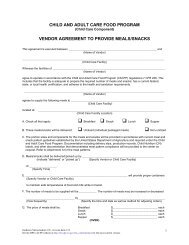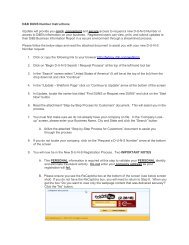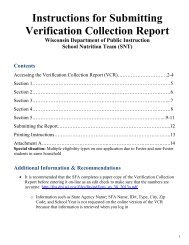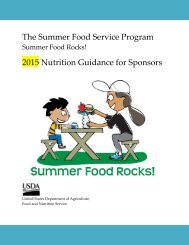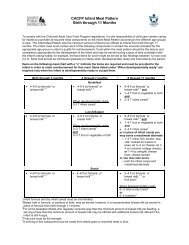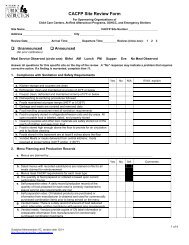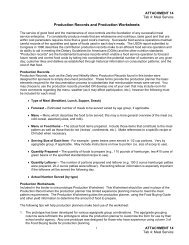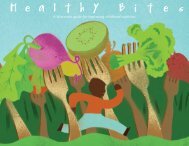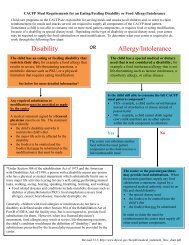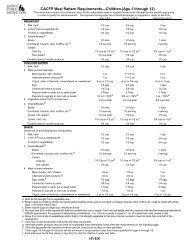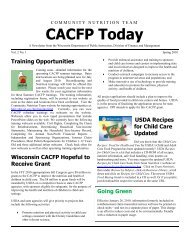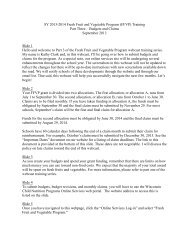Guidance Memorandum 12C - WI Child Nutrition Programs (FNS)
Guidance Memorandum 12C - WI Child Nutrition Programs (FNS)
Guidance Memorandum 12C - WI Child Nutrition Programs (FNS)
Create successful ePaper yourself
Turn your PDF publications into a flip-book with our unique Google optimized e-Paper software.
<strong>Guidance</strong> <strong>Memorandum</strong> <strong>12C</strong>: CACFP Meal Pattern RequirementsF. The CACFP Infant Meal PatternA center must follow the Infant Meal Pattern until the infant reaches one year of age; once the infant turns oneyear of age, (s)he must be served meals that follow the CACFP Meal Pattern Requirements – <strong>Child</strong>ren (Ages 1through 12).1. Infant Meal ReimbursementIn order to claim infant meals for reimbursement, each meal and snack must contain specific componentsaccording to age group which include iron-fortified infant formula or breast milk, iron-fortified infant cereal,and other foods as shown in the CACFP Infant Meal Pattern chart.Webcast Training: The DPI webcast CACFP Infant Meal Pattern located athttp://fns.dpi.wi.gov/fns_cntwebcasts explains the CACFP Infant Meal Pattern requirements.2. Definitions from the United States Department of Agriculture (USDA) Infant—A baby from birth through 11 months (any child less than one year of age). Infant Formula—Any iron-fortified infant formula, including soy-based, intended for dietary use solely asa food for normal, healthy infants served in liquid state according to manufacturer’s recommendeddilution. Infant formula labeled low-iron or those specifically formulated for infants with inborn errors ofmetabolism or digestive or absorptive problems do not meet the infant meal pattern requirement. Amedical statement is required in order for the center to serve/claim reimbursement for infant formulasthat do not meet this definition. Infant Cereal—Any iron-fortified dry cereal specially formulated for and generally recognized as cerealfor infants that is routinely mixed with breast milk or iron-fortified infant formula prior to consumption. Developmentally Ready—An infant’s developmental readiness determines which foods should be fed,what texture the foods should be, and which feeding styles to use. All infants develop at their own rate.Although age and size often correspond with developmental readiness, these should not be used assole considerations for deciding what and how to feed infants. It is important to be aware of infants’rapidly developing mouth patterns and hand and body control so you know the appropriate food andtexture to serve them and the appropriate feeding style to use at each stage of their development. Onthe Infant Meal Pattern for ages 4 through 11 months, you will see foods listed under the categoryWhen Developmentally Ready. If an infant is developmentally ready, you must offer these foods to theinfant.3. Purchasing Infant FoodsThe USDA requires that all agencies participating in the <strong>Child</strong> and Adult Care Food Program purchase andprovide at least one infant formula and all infant foods appropriate for the age of the infant according to theInfant Meal Pattern, regardless whether the agency chooses to claim infant meals and snacks forreimbursement. It is recommended to select an infant formula that satisfies the needs of one or more of theinfants in care.4. Infant Meal Notification of Center Provided Formula and Baby FoodsThe attached CACFP <strong>Child</strong> Participation Form (PI-6077-A) or Infant Meal Notification Letter lets theparent/guardian know the specific brand of infant formula purchased and provided by the center. It alsoprovides official documentation of the parent’s/guardian’s decision to accept or decline the formula and/orinfant foods offered by the center. This document must be completed by the parent/guardian and kept onfile for each infant. Please include a copy of the CACFP Infant Meal Pattern with the CACFP <strong>Child</strong>Participation Form or Infant Meal Notification Letter prior to distributing to parents.5. Parent Provided Infant Formula/Breast MilkThe decision whether to breastfeed an infant or which type of infant formula is best for the infant is one forthe infant’s doctor and parent/guardian to make together. Therefore, parents/guardians may elect to declinethe offered infant formula and supply their own infant formula or breast milk. This must be documented onthe CACFP <strong>Child</strong> Participation Form or Infant Meal Notification Letter.Infant formula: When parents/guardians supply the infant formula and it is the only item required to beoffered to the infant, those meals/snacks may be claimed for reimbursement. Once the infant isintroduced to semi-solid foods, according to the Infant Meal Pattern, the center must purchase andprovide at least one of the semi-solid foods offered for each meal/snack in order to claim the infant’smeals/snacks for reimbursement.Breast milk: When a mother elects to breastfeed her infant at the center the meals/snacks cannot beclaimed for reimbursement unless the child is also eating semi-solid foods, according to the Infant MealPattern, and the center purchases and offers at least one of the food items. However, if breast milk isRevision Date: 10/14All <strong>Guidance</strong> <strong>Memorandum</strong>s for the <strong>Child</strong> Care Component: http://fns.dpi.wi.gov/fns_centermemos2



